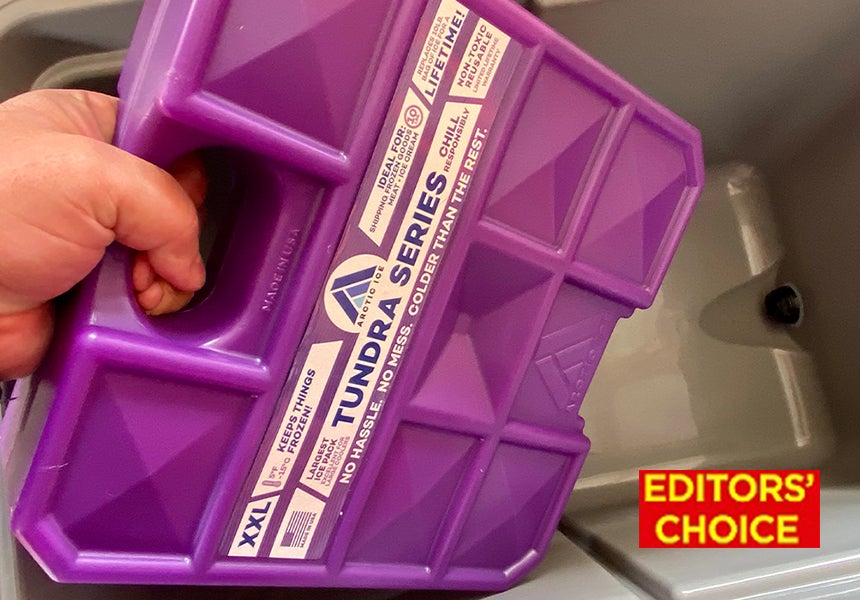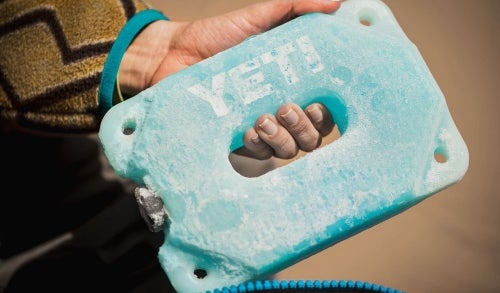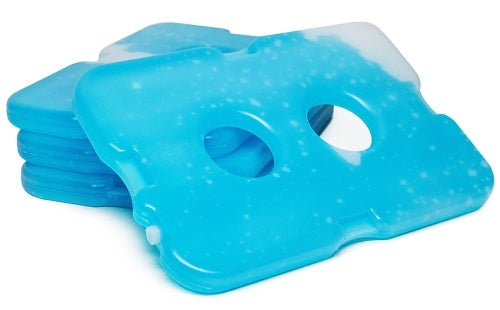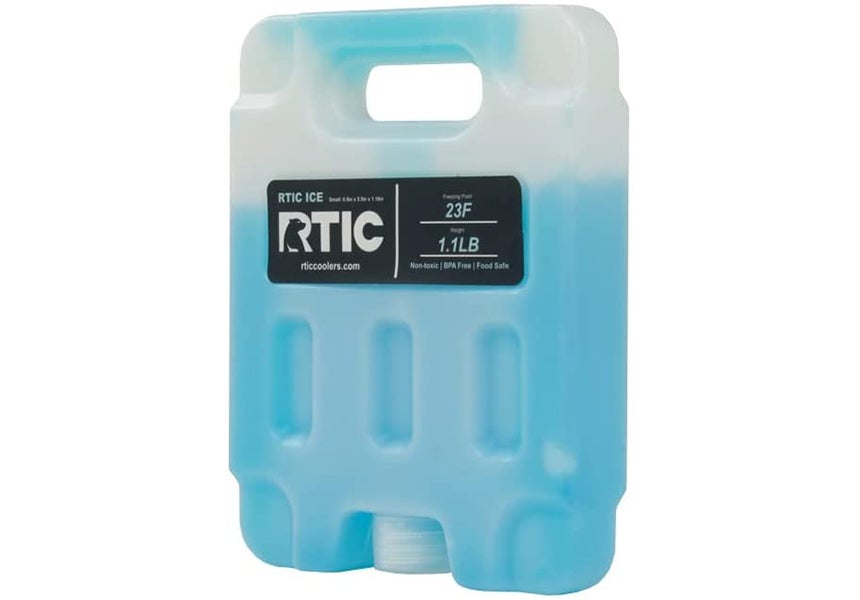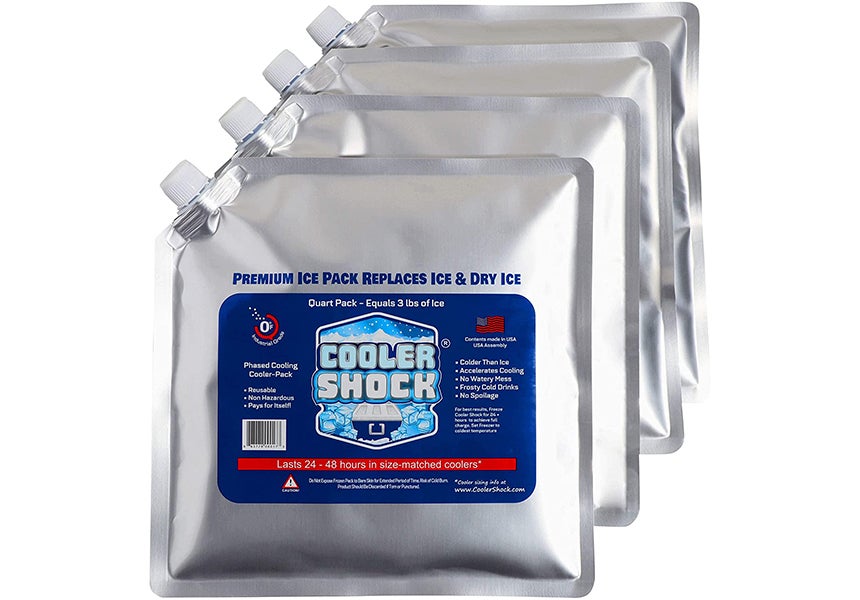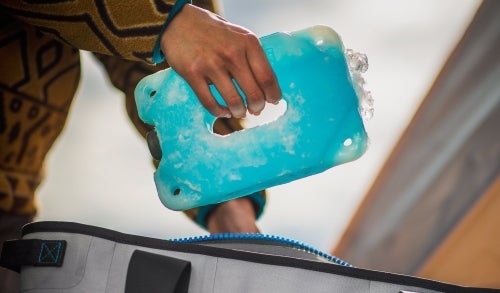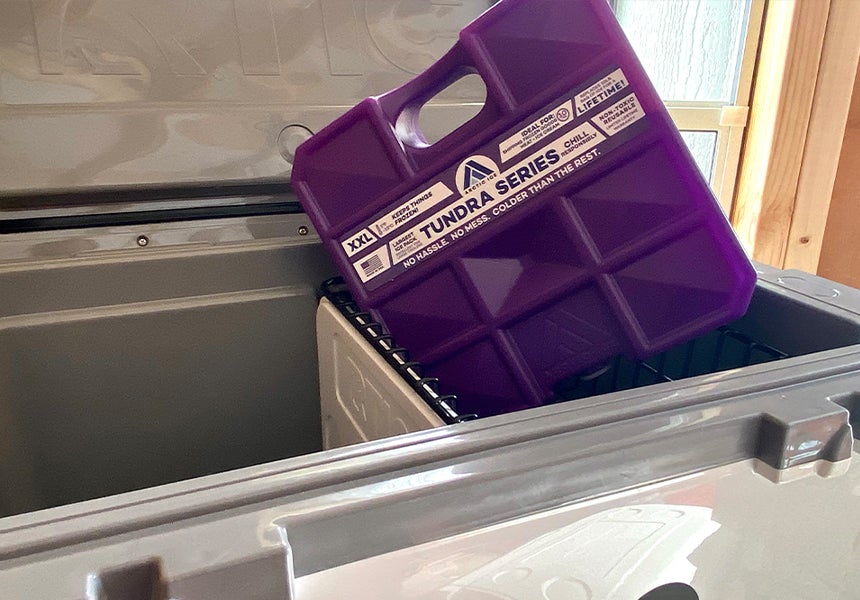
Our Editors independently research, test, and rate what we feel are the best products. We use affiliate links and may receive a small commission on purchases.
It is a fair guess that you have a cooler somewhere in your house. We all do. Coolers are a great way to keep our cold stuff cold when we travel, camp or go for a picnic. I always keep one in the truck for summer runs to the grocery store. But a cooler is only as good as long as there is cold stuff inside it, and to help keep your cold stuff cold, many of us use ice. Ice is good for use in coolers because it’s cold, cheap and easy to find – most of the time. However, there is a major drawback to ice in that it doesn’t last that long, and it is heavy. This is where the reusable ice pack comes into play. An ice pack is basically a compact container that uses a freezable material that retains its temperature for longer than frozen water. We all know a frozen block of ice lasts longer than a pile of ice cubes. Imagine taking that a step further and having a block of ice pack that lasts even longer than a block of ice, yet can take up less room? That’s where the best ice packs for coolers come in. simply put, they stay cold longer while taking up less space.
Best Ice Packs for Coolers
Also see: Ice Packs Comparison Table
Quick Answer: The 5 Best-Rated Ice Pack for Coolers
- Arctic Ice Tundra Series
- YETI ICE Re-Freezable Reusable Cooler Ice Pack
- Healthy Packers Cool Pack
- RTIC Chillers Ice Pack
- Cooler Shock Ice Packs
Ice Packs for Coolers Reviews
#1 Editor’s Choice – Arctic Ice Tundra Series
Specifications
- Dimensions: XXL 10.5″ x 10.5″
- Safety Features: Non-hazardous
- Gel or Water: Proprietary blend
- Made In: USA
- Lasts For: Varies, Avg. 72 hours
- Temperature: 5F
- Product Options: Sizes from small to XXL
- Purchase Guarantee: Limited Lifetime Warranty
With the influx of roto-molded “super” coolers these days, it didn’t take long for several companies to come in with ice-alternative products that helped with the cold-retention that makes those coolers so popular. One of the first and best is Arctic Ice’s Tundra Series. I have the 10lb XXL size and use it in several different coolers. This ice pack has some interesting features to it, starting with a freezing point of 5°F, meaning the big XXL size may take several days to actually freeze completely. It takes up less space than a 10lb block of ice, and it will last much longer due to the freezing point. I put it into a 52-quart RTIC Ultralight cooler and it kept my frozen stuff frozen and actually started forming ice in a bottle of pop.
It is not quite as cold as a similar size block of dry ice, but is reusable as many times as you want to use it. Plus, it can be run through the dishwasher on the top shelf if it gets nasty. The only downside to it, and this goes for just about every ice pack I’ve ever used, is that once it gets warm, it’s just taking up space. You need to pack your cooler right to make it last, and if you do, you’ll be rewarded with long-lasting cold.
#2: Best Gel Ice Pack – YETI ICE Re-Freezable Reusable Cooler Ice Pack
Specifications
- Dimensions: YETI ICE 1 lb – 8″ x 2 5/8″ x 1 5/8″
YETI ICE 2 lb – 8″ x 5 3/8″ x 1 5/8″
YETI ICE 4 lb – 10 3/4″ x 8″ x 1 5/8″ - Safety Features: Non-toxic, food safe
- Gel or Water: Gel
- Made In: Not specified
- Lasts For: 4 – 8 hours
- Temperature: -2C or 28F
- Product Options: 1 lb, 2 lb or 4 lb reusable ice packs
- Purchase Guarantee: Not specified
This ice pack freezes quick and works fast, but it doesn’t last as long as some of the other ice pack bags we’ve reviewed. It stays freezing cold for 4 hours, but it can start to lose its chill after that. This ice pack is handy for emergency uses, as opposed to long trips that require prolonged cold. These fit perfectly into Yeti Tundra, Roadie, and Hopper coolers, but can be used in any cooler or compartment that needs to be kept cold.
#3: Budget Pick – Healthy Packers Cool Pack
Specifications
- Dimensions: 7″ x 4.8″ x 0.7″
- Safety Features: Made with 100% BPA free, non-toxic materials
- Gel or Water: FDA-approved gel
- Made In: China
- Lasts For: 6 – 12 hours
- Temperature: Not specified
- Product Options: Set of 4 or 8 reusable cold packs
- Purchase Guarantee: 100% money back guarantee if dissatisfied with product
This product is a great kids ice pack thanks to the 100% BPA free non-toxic material it is made of and the FDA approved gel. It lasts the school day, so if your kid doesn’t finish their lunch, it’s still edible to have as a snack when they get home.
#4: RTIC Chillers Ice Pack
Specifications
- Dimensions: 6 x 5.5 x 1.25 inches (Small size, options available)
- Gel or Water: Gel
- Made In: Not specified
- Lasts For: Varies
- Temperature: 23F
- Purchase Guarantee: unspecified
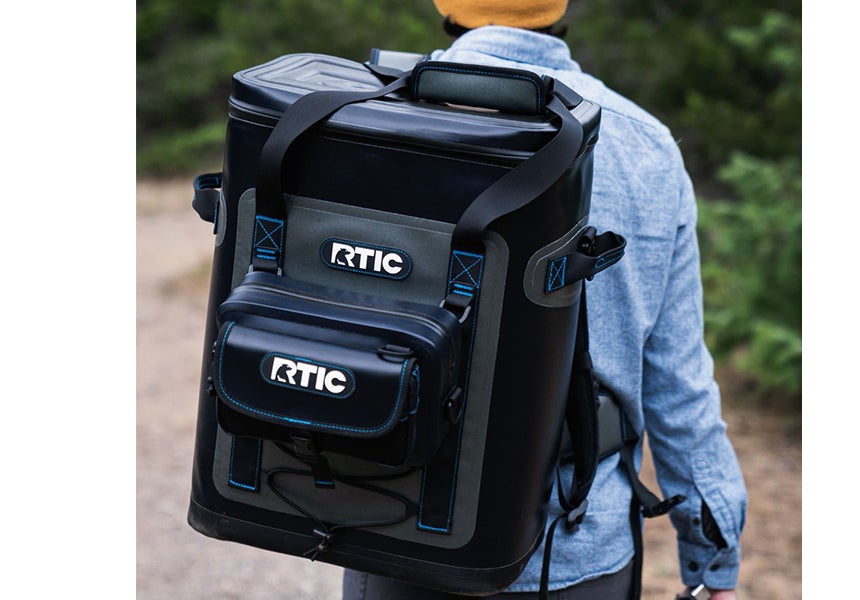
Their Chillers ice packs are available in sizes from small through extra-large. They freeze at 23-degrees F and can freeze in just 4-5 hours depending upon the size. They match well with RTIC coolers, but will work wherever you need them to.
#5: Cooler Shock Ice Packs
Specifications
- Dimensions:10 x 14 x 1.5 inches
- Safety Features: Non-toxic, BPA free
- Gel or Water: Polyethylene
- Made In: USA
- Lasts For: 24-48 hours
- Temperature: 18 F
- Product Options: Three size options
- Purchase Guarantee: Defective products are replaced
These ice packs come in several sizes and are a great, cost-effective way to keep things cool. They are not like some other packs in that they can be molded around things, making them great for use in icing down knees and other body parts, and are great for post-surgery care. They freeze at 18-degrees F and can stay frozen and cold for up to 48 hours.
How to Choose the Best Ice Pack
- Why Regular Ice Doesn’t Cut It in A Cooler?
- What about adding salt to ice in my cooler?
- Dry Ice Vs. Reusable Ice Packs
- Important Ice Pack Terminology
- Safety Terms
- Ice Pack Purchase Considerations
Every family that enjoys the great outdoors needs reliable refrigeration for food and drinks. In this article we will discuss the best ice packs for coolers, and how to decide which is best for you. Whether your activity is camping, fishing, hiking, or canoeing, you need a trusted cold pack to make sure your water and food stay chilled so it doesn’t spoil, and leave you and your family thirsty and hungry. Without cold water and palatable food, the most picture-perfect family outing can quickly be turned into a frustrating day of bickering and stomach growls.
Why Regular Ice Doesn’t Cut It in A Cooler?
If you’ve ever tried to keep your cooler chilled with good old fashioned regular ice, you already know why it doesn’t even come close to the function and ease of use of reusable ice packs. Water reaches freezing point at 0° C (32° F). Once you take ice out of the freezer keeping it at this temperature, it begins to melt. Without special additives, packaging, insulation, or energy-transferring covers, it can rapidly turn your cooler into a bath tub with floating lukewarm snacks.
Let’s face it, ice is gross when it melts. It ruins everything you have in the cooler, and it’s annoying. The biggest thing it has going for it is that it’s cheap.
What about adding salt to ice in my cooler?
Adding rock salt to your cooler ice does effectively lower the freezing/melting point of it. It keeps ice colder longer, so it doesn’t melt as quickly. However, it doesn’t last as long as many of the ice packs on the market, and it will still leave you with a watery mess in the end.
Dry Ice vs. Reusable Ice Packs
Dry ice is actually carbon dioxide – it’s what you breathe out when you exhale, and it’s what makes soda fizzy. Dry ice is incredibly cold. It averages about negative 109.3 degrees Fahrenheit or negative 78.5 degrees Celsius.
The biggest difference between dry ice and regular ice, besides the temperature, is that it does not liquefy as it warms. Dry ice becomes a gas that fades away. This may seem great, but there are serious downsides to it. Because it is so severely cold, you need to handle it very carefully. You cannot touch it with bare hands. Dry ice must be handled with protective cloth – like an oven mitt or towel – or leather gloves. Prolonged touching or contact to skin will cause an injury similar to a burn.
Really, dry ice is best for freezing items that aren’t going to be used for a long period of time. This is why most mail-ordered meats come packaged in dry ice. Also, dry ice can’t be used in a regular cooler. It can only be used in coolers that are specifically designed for it. Dry ice isn’t very versatile, and requires a lot of planning. It’s not a good option to pop in your cooler on an outdoor weekend getaway.
Important Ice Pack Terminology
All products have their own vernacular. You’ll likely see the following terms while you’re shopping for the best cooler ice packs:
General Terms
- Reusable – Products that are intended to be used more than once. This might indicate a two-use product, or a product that will last you for five years. It’s all relative, so read up on your product and check out reviews.
- Subzero temperature – Just a fancy way of saying any temperature below 0 degrees celsius.
- Break-resistant – These ice packs claim to be durable and totally unbreakable. Companies that claim this normally have a warranty to cover their claim.
- Hard shell – An ice pack which has a hard outer exterior that is not moldable. This is important to note when sizing up the right ice pack to fit in your cooler.
Safety Terms
- Non-toxic – These are products that claim to be non-poisonous, safe, and non-irritating when used as the manufacturer intended. However, it’s important to be aware that there is no standard right now for judging whether a consumer product (or its ingredients) are non-toxic and have been verified as such. According to the Consumer Product Safety Commission, some companies put the non-toxic label on products that don’t meet the definition of toxic – but this doesn’t necessarily mean the product should be considered non-toxic. Always use ice packs carefully, and look into the product contents and company if you doubt the label.
- Non-hazardous – These products claim they do not contain any chemicals, liquids, solids or gases that can harm people, other living organisms, or the environment. Just because a product doesn’t meet the requirements of a hazardous or dangerous good, it doesn’t necessarily mean it is fully non-hazardous.
- Environmentally friendly – These products claim to be sustainable and either reduce, cause minimal damage or no impact at all on the environment and ecosystem. Like the previous safety terms, this label is often used as a marketing ploy and doesn’t mean much unless it is stamped by an authority or regulator.
- BPA-Free – BPA-free products do not contain bisphenol A (BPA), which is a compound that has been linked to adverse health effects like infertility, diabetes, and cardiovascular problems.
Ice Pack Purchase Considerations
- Size – This should go without saying, but make sure you select an ice pack that can actually fit in your cooler! Consider both the width and height of an ice pack. It might fit in one way, but not the other. And always keep in mind, you will have other things in your cooler than the ice pack. You should have plenty of room for drinks and snacks.
- How long it stays cold – Do you go on afternoon hiking and fishing adventures, or do you like to go camping for a whole weekend? This is the second most important factor to consider after the size of a cooler ice pack. There’s nothing worse than getting excited for a new product and then realizing it doesn’t meet your needs. Think about your requirements carefully before purchasing a cooler pack.
- Weight – If you are going to physically carry your cooler on a long trek, weight is definitely something to consider. Ice packs can range in weight, depending on the size and freezing agent.
- Construction – If you have young children who tend to get into your cooler, it might be smart to get soft ice packs just in case they decide to throw one at their sibling. It you know your cooler gets thrown around, you’ll want to get a hard shell to reduce the likelihood of it breaking or leaking. Many ice packs have a hard shell, so don’t count on an ice pack being flexible to fit into your cooler. Soft ice packs will be labelled as such.
Frequently Asked Questions
How long with a reusable ice pack last in a cooler?
There are a lot of variables, including how full the cooler is, what the cooler is made of and the outside temperature, but a basic guideline is that the average ice pack will last 24-48 hours in a cooler with cold things in it already. Some last longer than others, too.
What is the best way to get my ice packs to last longer in my cooler?
Start out with everything in the cooler being at the lowest temperature you want. If everything is frozen, that is a good start. Ice packs will lose effectiveness if they are expected to lower the temp of something you add to the cooler. Also, store your cooler out of direct sunlight and don’t open it more than you have to. It also helps to fill the cooler as much as possible, as air is not your friend when keeping a cooler cold.
Where do I put the ice pack in my cooler?
Always put your ice and ice packs in the bottom of the cooler to get them to last longer. Heat rises, and therefore, your cooler will work better with the coldest stuff at the bottom.
How We Researched
It was rough, but we did the work on this one. We went camping and boating and off-roading… Seriously though, we researched by using these ice packs as they were intended to be used. Just like you would do, we used them to keep our coolers cold and our stuff cold and/or frozen. The average temperatures were in the 70s and 80s, with some going above and beyond that, with coolers shut in vehicles in the summer sun. We also talked to our friends, co-workers and others to see how their experiences went.
Recent Updates
04/18/2022: Added Arctic Ice as Editor’s Pick and replaced out of stock items; Added editor’s awards; Added Frequently asked questions; Added original photography; Updated and added to the text to give you more information

